Original Title: Crypto Marketing Trends & Predictions: 2026 and Beyond
Original Author: @emilyxlai
Translated by: Peggy, BlockBeats
Editor's Note: The marketing landscape in the crypto industry is undergoing a profound transformation: trend lifecycles are becoming shorter, competition is intensifying, and traditional strategies are gradually becoming ineffective. For entrepreneurs, growth leaders, and marketing teams, understanding these changes is not just a matter of survival but also key to seizing opportunities.
This article is based on a presentation by Hype Partners' Chief Marketing Officer Emily Lai, systematically outlining the seven core trends in crypto marketing for 2026, covering recruitment, performance marketing, content creation, channel diversification, event experiences, incentive mechanisms, and AI-driven operations. It also shares industry predictions and a framework for staying ahead.
The industry is evolving rapidly; how can we seize opportunities and avoid falling behind? This article provides the answers.
Below is the original text:
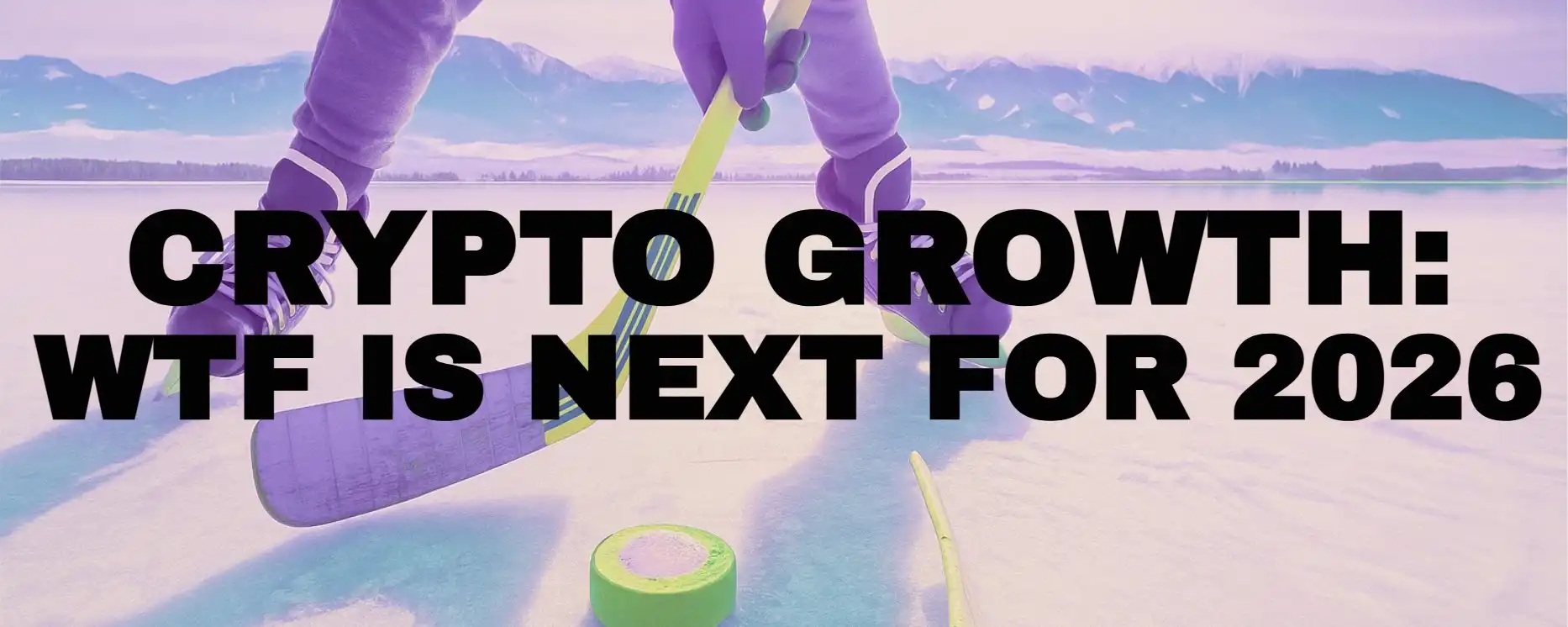
The crypto industry is fast-changing, with extremely short attention cycles; trends emerge quickly and disappear even faster, with lifecycles tightening further.
At the g(t)m con1 conference held last Sunday (November 16), I shared observations and experiences from the past year and made forward-looking judgments for 2026.
The core of this presentation was to share our team's insights on the future of the industry with entrepreneurs, growth leaders, and marketing experts, discussing what this means for your market strategy and how to stay ahead in competition.

Ten months can change a lot

Since my keynote speech at the EthDenver conference in February 2025, we have witnessed: over 319 new stablecoins; institutional and Wall Street entry in forms such as corporate blockchain, DAT, ETF, and fintech giants adopting stablecoins; a relaxed regulatory environment with the introduction of the GENIUS Act, and the U.S. welcoming a "crypto-friendly" president; a more than 27% increase in new token issuance, reaching 567 million at the time of writing; a surge in crypto payment card options, with $375 million in card transactions on traceable blockchains in October 2025 alone; an explosion in prediction markets, with @Kalshi and @Polymarket setting new trading volume records and new players entering the space; and the launch of new banks and mobile-first financial applications based on crypto rails.
Crypto in 2024 vs. Today

Last November, the first g(t)m con was held in Bangkok. The main trends at that time included: team-led marketing, founder personal branding, AI agents, interactive "reply experts," brand mascots, airdrops, intern accounts, and the mysterious concept of "mindshare" proposed by the InfoFi platform.
A year later, the industry landscape has clearly shifted: from a liquidity focus in the Asia-Pacific region to the return of ICOs, and the rise of "CT Leads," the pace of change in the crypto industry is astonishing.
User Mindshare ≠ Growth

RIP Mindshare
In the past year, several highly anticipated TGEs (Token Generation Events) experienced weak buying pressure despite high attention, with price performance far below crypto Twitter (CT) sentiment expectations. From a KPI perspective, the industry has refocused on user acquisition (covering B2B and B2C) and retention.
In terms of narrative and industry meta-trends, ecosystems and applications are beginning to reinforce the messaging of "revenue and buyback." Internal discussions are also centered on token strategies, token economic models, and incentive designs to alleviate selling pressure.
As infrastructure, underlying protocols, and middleware gradually improve, the industry's focus is shifting from chains and ecosystems to applications. When traditional financial institutions begin to deploy capital and fintech applications with millions of users connect to blockchain rails, this not only brings legitimacy to the entire industry but, more importantly, allows us to reach new users beyond CT.
With improved user experiences, the emergence of new applications, and the establishment of trust, the addressable market size and audience are continuously expanding. This also means that previously considered negative ROI/ROAS Web2 user acquisition strategies are beginning to regain rationality.

Trends: Hot and Not
Here is a subjective and incomplete list of "in vogue and out of style." I first organized my own views, then gathered opinions from a crypto VC friend, as well as insights from crypto marketing circles and CT.

Subsequently, I broke down these trends and observations into seven themes, providing a high-level overview and synthesis of my learnings and observations from 2025.
Originally, I had only 25 minutes for the presentation, but thanks to @clairekart's understanding, I shared in a "stream of consciousness" style for 45 minutes.
Recruitment and Employment Market for Growth Roles

Check out the latest marketing job section launched by @safaryclub
As the industry matures, we see later-stage companies and Web2 enterprises becoming increasingly specific in their requirements when hiring crypto marketing talent, moving away from the traditional "jack-of-all-trades marketing leader." Several recruiters have also mentioned a noticeable increase in demand for senior or leadership marketing positions (such as CMO), with reduced flexibility for remote work and an increased acceptance of Web2 marketing talent.
For junior marketers without Web2 marketing experience, the bar is higher than ever, as the market is flooded with crypto-native talent (think of the ecosystems that have failed or faded over the past four years).
Performance Marketing
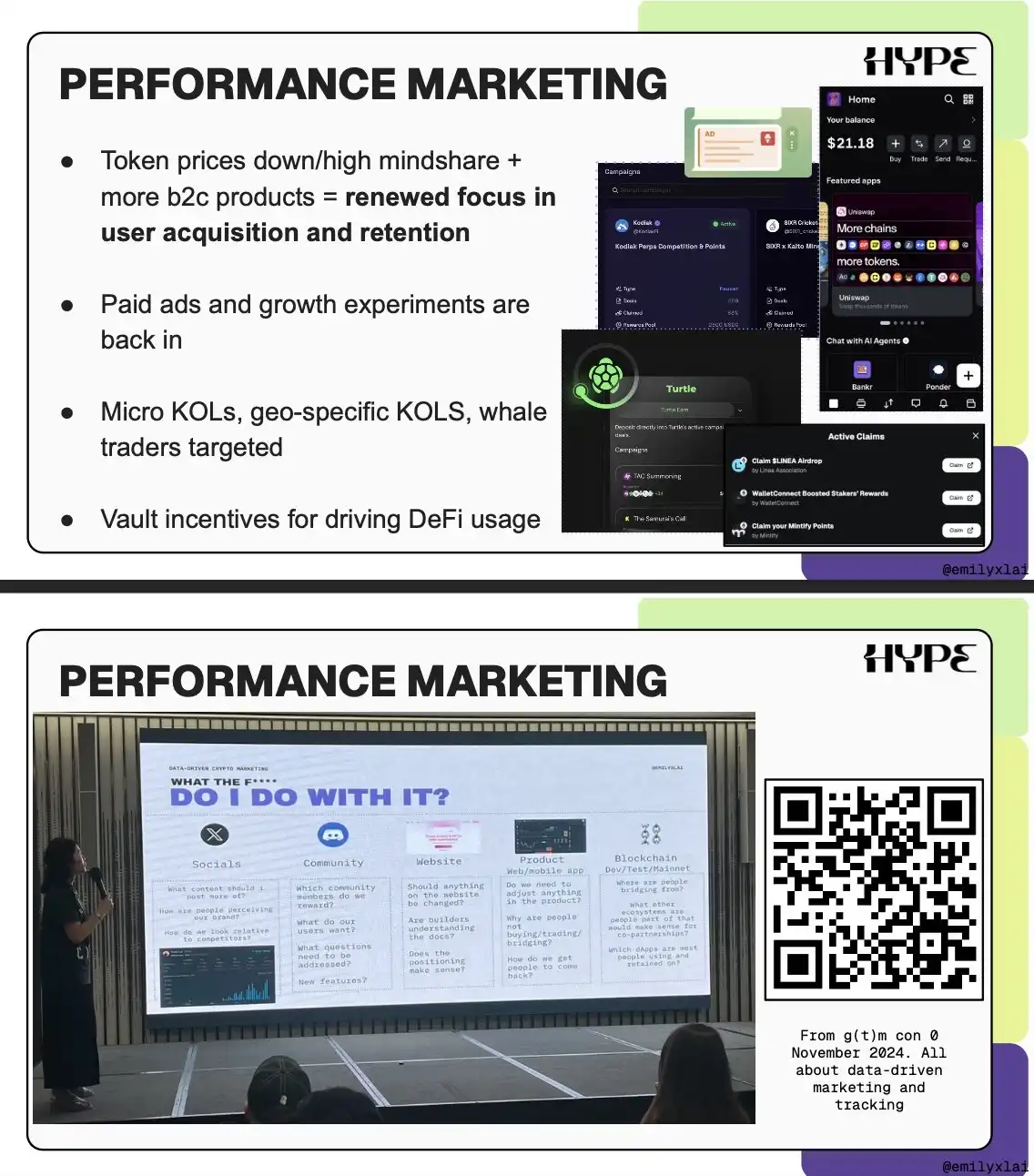
At last November's g(t)m con in Bangkok, I shared insights on data-driven marketing, focusing on funnel models and key metrics. What seemed important then is even more relevant now.
Performance marketing is making a comeback, driven by the industry's renewed focus on user acquisition and retention. This means: installing tracking tools (on-chain, product/web, distribution channels); growth experiments; a combination of paid and organic traffic; evolving from social tasks to liquidity tasks; and precise KOL marketing campaigns.
We are seeing more projects using or inquiring about tools such as:
@spindlxyz, @gohypelab, @themiracleio: for native wallet placements
@tunnl_io, @yapdotmarket: for targeted bounty campaigns for small KOLs
@turtledotxyz, @liquidity_land: for liquidity marketing activities
Additionally, there are more precise strategies: I have spoken with some perpetual contract DEXs that employ "white glove" user guidance, even reaching out to whale users one-on-one via private messages, or leveraging trading KOLs in the Asia-Pacific region to gain initial traffic (of course, accompanied by rewards).
At the same time, paid advertising channels from Web2 are re-entering the spotlight, including paid social, search ads, and out-of-home (OOH) advertising. One still underestimated channel is Telegram advertising. In the future, as AI ecosystems like LLM and OpenAI build advertising product suites, we will also see new advertising scenarios.
Content, Content, and More Content

This year, we have seen explosive growth in content creators and videos on social platforms, with timelines flooded with various types of content: from vloggers and short video creators to technical explainer videos, live streams, and even cinematic storytelling…
At the same time, the InfoFi platform has driven the rise of "brand ambassador" roles, where individuals generate buzz for projects through active posting ("yap") in hopes of earning rewards. However, I believe this trend will not last; I have placed "yappers" on my OUT list.
As I left the DevConnect venue last week, I joked that DJI's revenue must have skyrocketed because there were microphones and cameras everywhere. We are in the season of content creators.
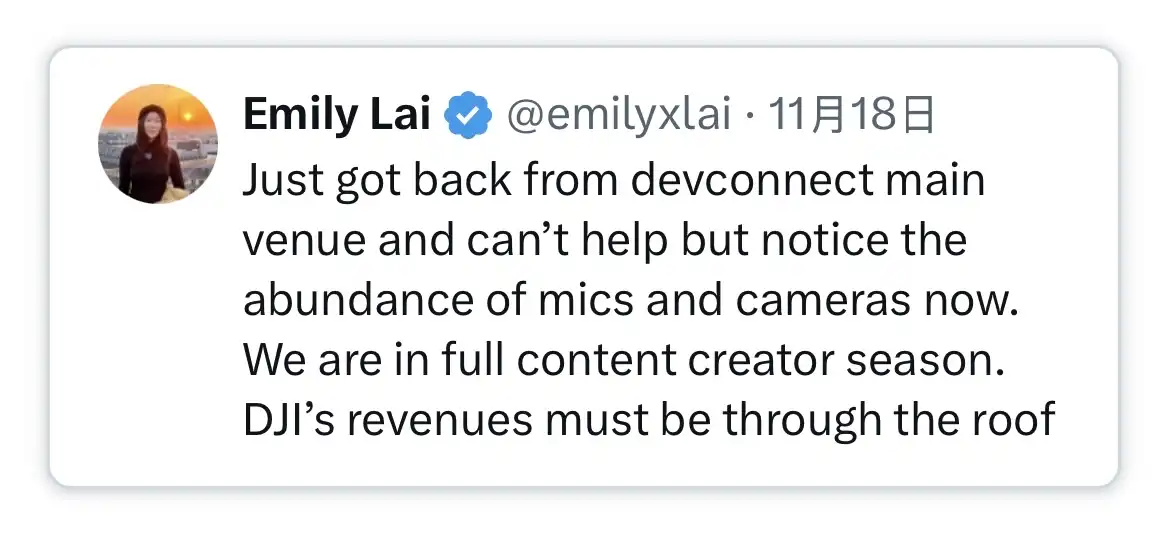
Some creators are freelancers producing content for their favorite brands, such as @coinempress and @DAppaDanDev. Brands are also beginning to hire dedicated content creators to produce videos, vlogs, host spaces, and even leverage creators' personal brands (like CT Leads @alexonchain). @dee_centralized is one of the leaders in the short video crypto wave.
Six weeks ago, I visited the @solana office in New York and toured Solana Studio—a content space designed for founders and creators, where @bangerz and @jakeclaychain produce content.
We also saw brands hiring actors, Hollywood-level studios, and photographers to create high-quality content and advertisements. @aave has started ramping up content on Instagram (a smart strategy to warm up for its retail mobile app), while @ethereumfnd has brought in storytelling creators like @lou3ee.
Content formats are also diversifying: in addition to text and video, there are live series (like @boysclubworld), static series, podcasts, short video clips, 3D or AI announcement videos, etc. @OctantApp provides funding for creators, and I recently held a workshop discussing the psychological factors brands value in content creation.

At Hype (@hypepartners), we hosted four content creator workshops during DevConnect week and introduced @web3nikki to lead a new short video department in January this year. Content will continue to saturate, and quality, depth, and production levels will become increasingly important, while reaching new users beyond CT is equally crucial.
The World Beyond X
This year at Hype, we explored (and re-explored) new channels, including YouTube, Reddit, AI SEO (like Perplexity, GPT), Instagram, and Whop. In my presentation, I highlighted LinkedIn and TikTok.

Take @Scroll_ZKP co-founder @sandypeng as an example: for someone who doesn't often use LinkedIn, she consistently posted throughout 2025, growing from zero to 6.3 million impressions and 31,000 followers, sharing her strategies and data (first time publicly, thanks Sandy).
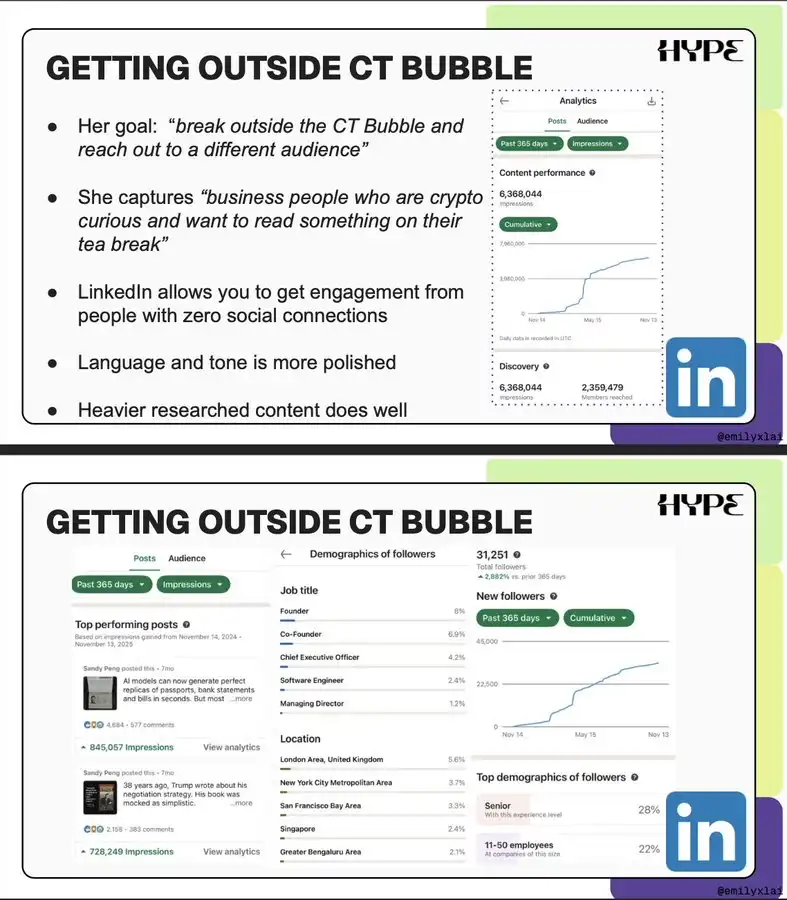
Sandy Peng (co-founder of Scroll) on LinkedIn
In January this year, we noticed a significant increase in brand demand for channels like Instagram, YouTube, and TikTok, leading us to bring in @web3nikki to establish a short video department focused on brand growth and user acquisition, with a particular emphasis on TikTok. All team members are native TikTok users, familiar with the algorithm, knowing how to create viral content, and able to adjust content strategies to a crypto perspective.

Since the department's establishment, we have collaborated with 12 clients, accumulating a wealth of experience and insights.
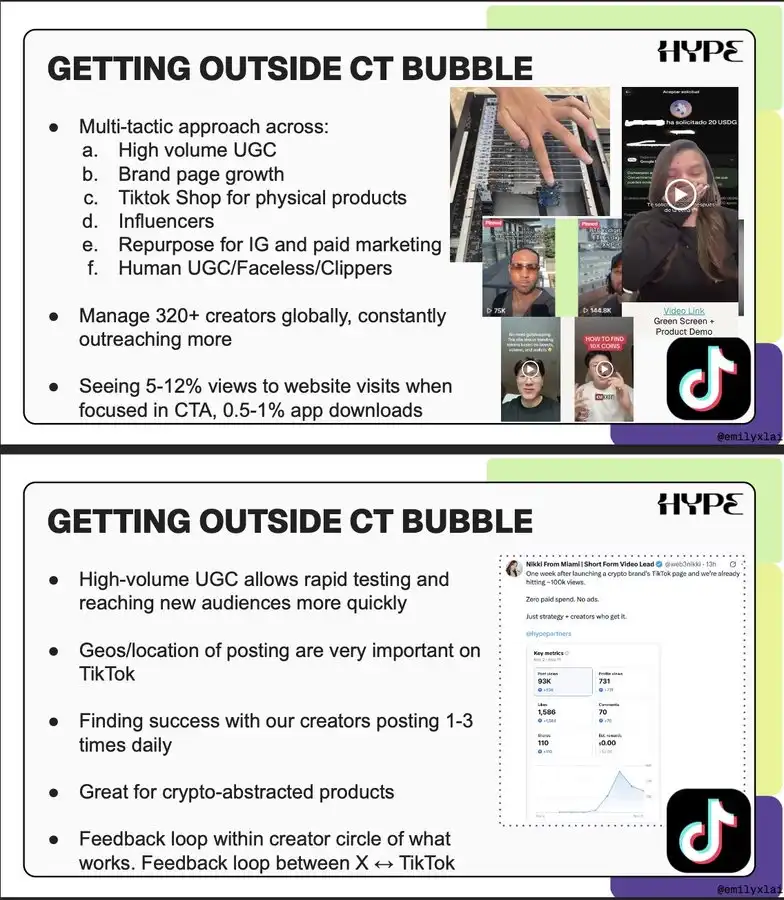
Events Becoming More Immersive and Exclusive

As crypto conferences become severely saturated (often exceeding 500 events in a single week), organizers are increasingly competing to attract participants. This trend extends to surrounding gifts: higher quality, more exquisite designs, and exclusive giveaways. This year, we saw a significant increase in private dinners.
@metamask set a new benchmark at the EthCC Cannes event in July: invite-only, taking KOLs and content creators on speedboats, helicopters, and planes.
@raave continues to lead the standard for crypto music events, inviting world-class DJs and creating top-notch stage designs. Ticket acquisition methods are tiered, exclusive, and gradually released through a series of marketing activities.
This experience is not only happening in real-world scenarios but also extending into the digital realm: airdrop unboxings, mini-games, Buzzfeed-style personality tests, and other shareable interactive experiences are becoming more prevalent. We see more inspiration drawn from Web2 brand events, pop-up concepts, and influencer events being introduced into the crypto space.
Last week, we held a candlelight concert with @octantapp, where you can see live clips. The event was invite-only, as the venue could not accommodate all 20,000 people. If you want to attend the next experience, please contact @cryptokwueen or me.

Restructuring and Redesigning Incentive Mechanisms
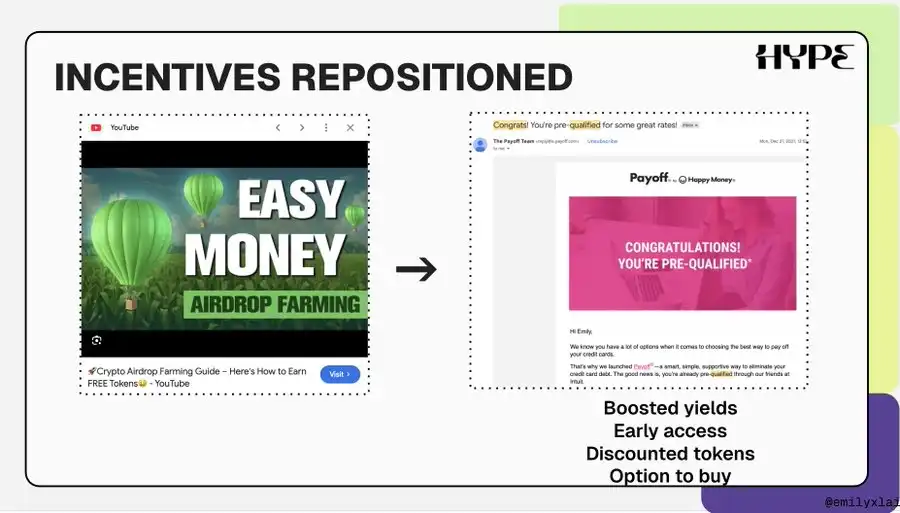
This year, we saw incentive activities returning from airdrops to ICOs. Some incentive activities have been repositioned as privileges:
"Being able to buy this token is a privilege in itself" (similar to NFT whitelist in 2021)
"Buy now, and you will gain the privilege of discounted purchases"
"Stake now to earn higher yields and/or points from multiple protocols"
"To receive the most airdrops, discounts, or points, you must enter the top-tier membership" (similar to airline and hotel loyalty programs)
All of this reminds me of banks and Web2 fintech companies that package the use and access of products as a privilege. My Chase emails often say, "Congratulations! You are pre-qualified for mortgage refinancing."
In the future, we will continue to see incentive programs evolve, increasingly aligning with the logic of loyalty and identity tier programs.
The Application of AI in Marketing and Operations
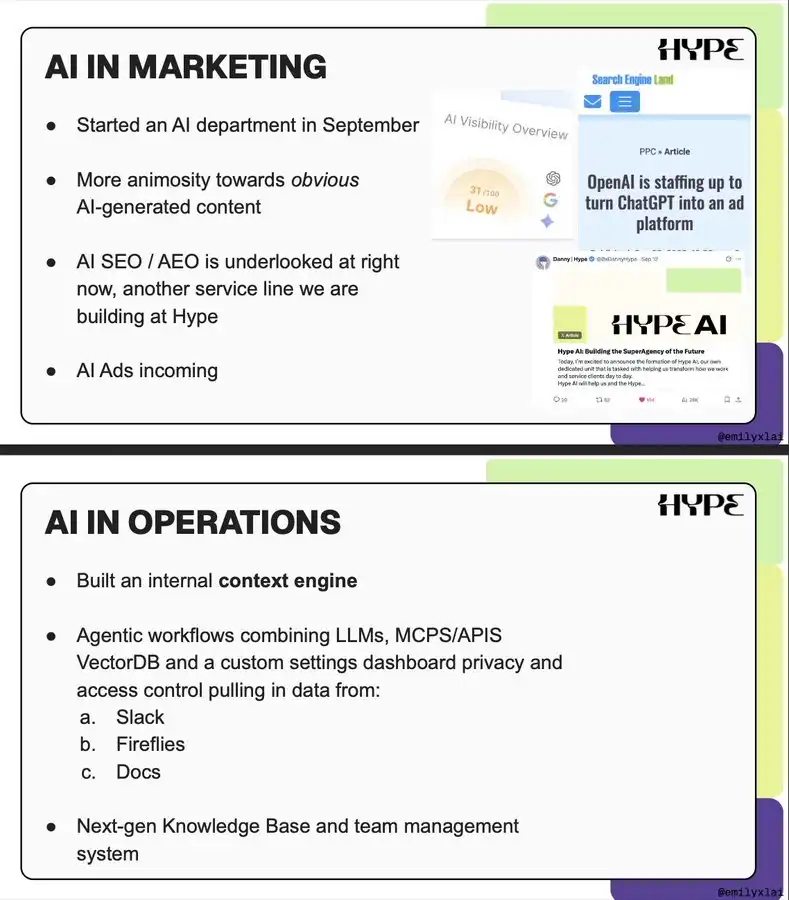
Here are the AI trends I see in marketing and our experience building an internal "context engine" at Hype.
In September this year, we established the Hype AI department, led by @antefex_moon (our AI VP). More details can be found in the introduction by CEO @0xDannyHype.

We are extensively testing AI at various stages to enhance work quality, research, operations, data measurement, and project management. This requires continuous testing and iteration.
We also launched a new service line: AI SEO / LLM SEO, which ensures your company appears in AI prompts, depending on whether it appears in the correct position in the training data. Web2 tools like Ahrefs and SEMrush have begun offering AI visibility measurement. Meanwhile, OpenAI has officially announced its exploration of an advertising platform, which will bring new advertising scenarios and marketing strategies.
Other Predictions
The trends and observations mentioned above directly influence some of the business and marketing decisions we make at Hype. Before sharing my "stay ahead" framework, I gathered predictions from the Hype team regarding crypto marketing. You can read insights from @0xdannyhype, @ChrisRuzArc, @groverGPT, @izaakonx, @Timmbo_Slice, and others:
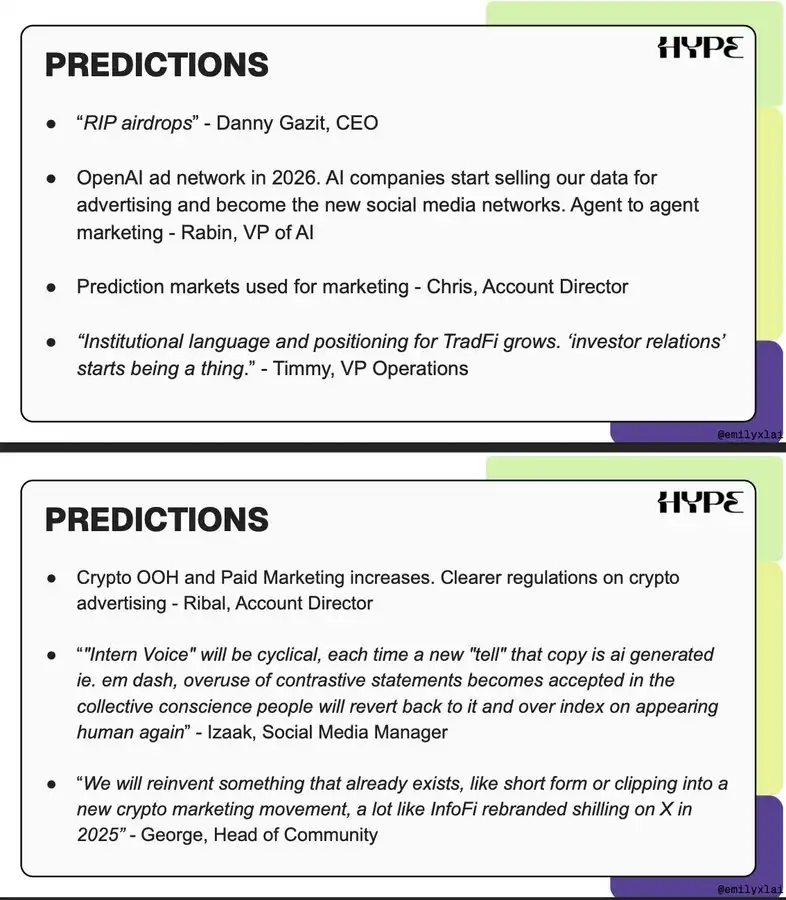
How to Stay Ahead
The lifecycle of trends is continuously shortening due to several reasons:
Weakened moats (for example, with the help of AI, the internet, and tools, creating content is easier than ever)
Limited audience size in the crypto industry
New companies emerging constantly, competing for attention every day
Marketing requires continuous innovation, testing, and experimentation. Teams that adopt new strategies first can leverage "freshness" to capture brand recognition until that strategy becomes saturated in the market. You can also retest old strategies and aesthetics to rekindle "novelty." This is an ongoing cyclical game.

When others turn left, you turn right; when everyone is turning left and right, you sit under a tree, enter a higher dimension, and explore untouched areas. Then repeat this process.
To stay ahead, you must: keep up with industry dynamics; draw inspiration from outside the crypto industry; think based on first principles (this requires brainstorming, deep thinking, and evaluation, not just copying others).
Some questions to help you define predictions and marketing bets include: Which trends will become obsolete in the next 6-12 months? Which strategies have been effective in Web2 or other industries but have not yet been applied in crypto? What user behaviors or technological changes will reshape marketing?

Ultimately, you are betting on the future. And betting on the future relies on seeing the patterns clearly and imagining better possibilities.
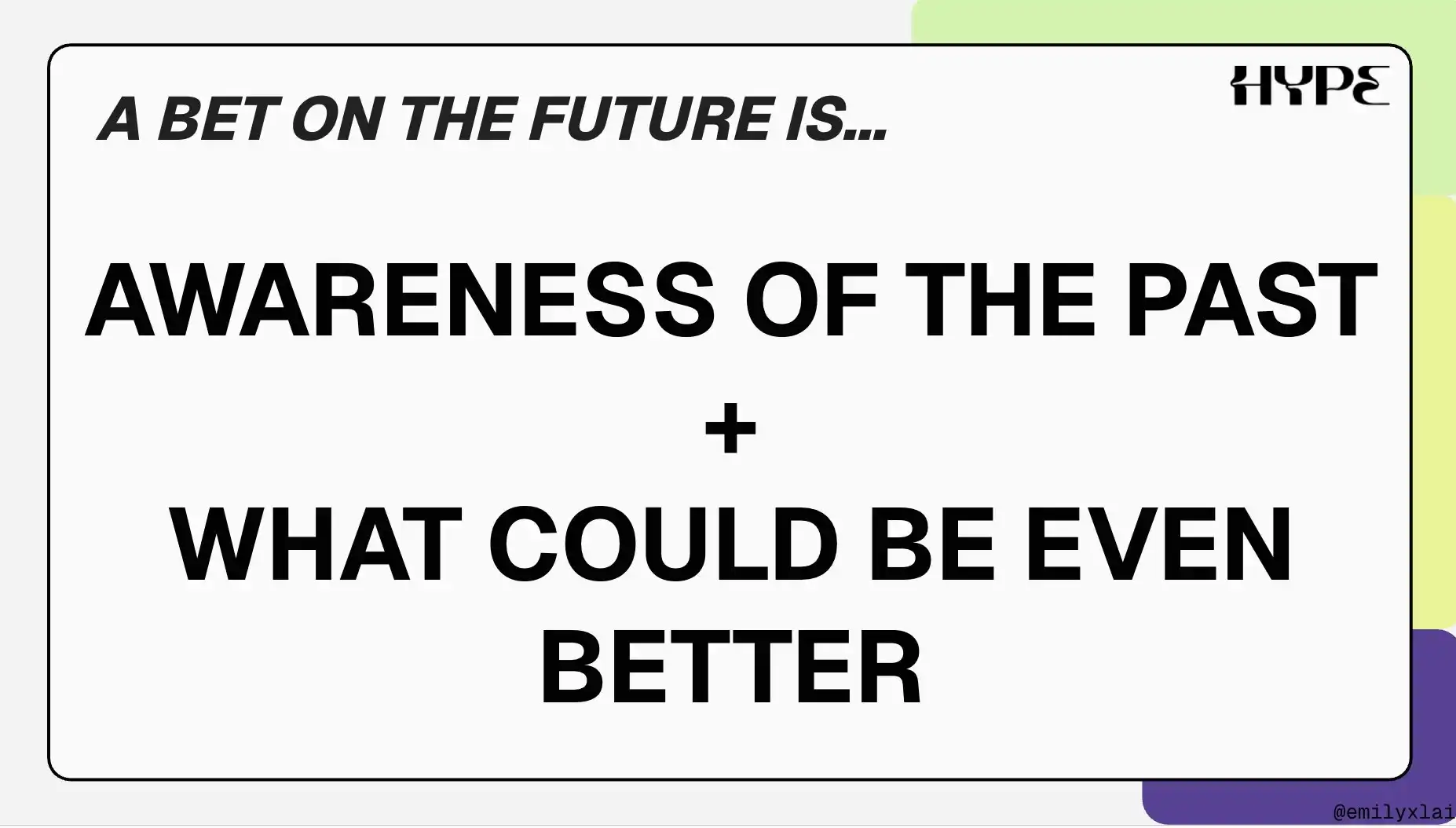
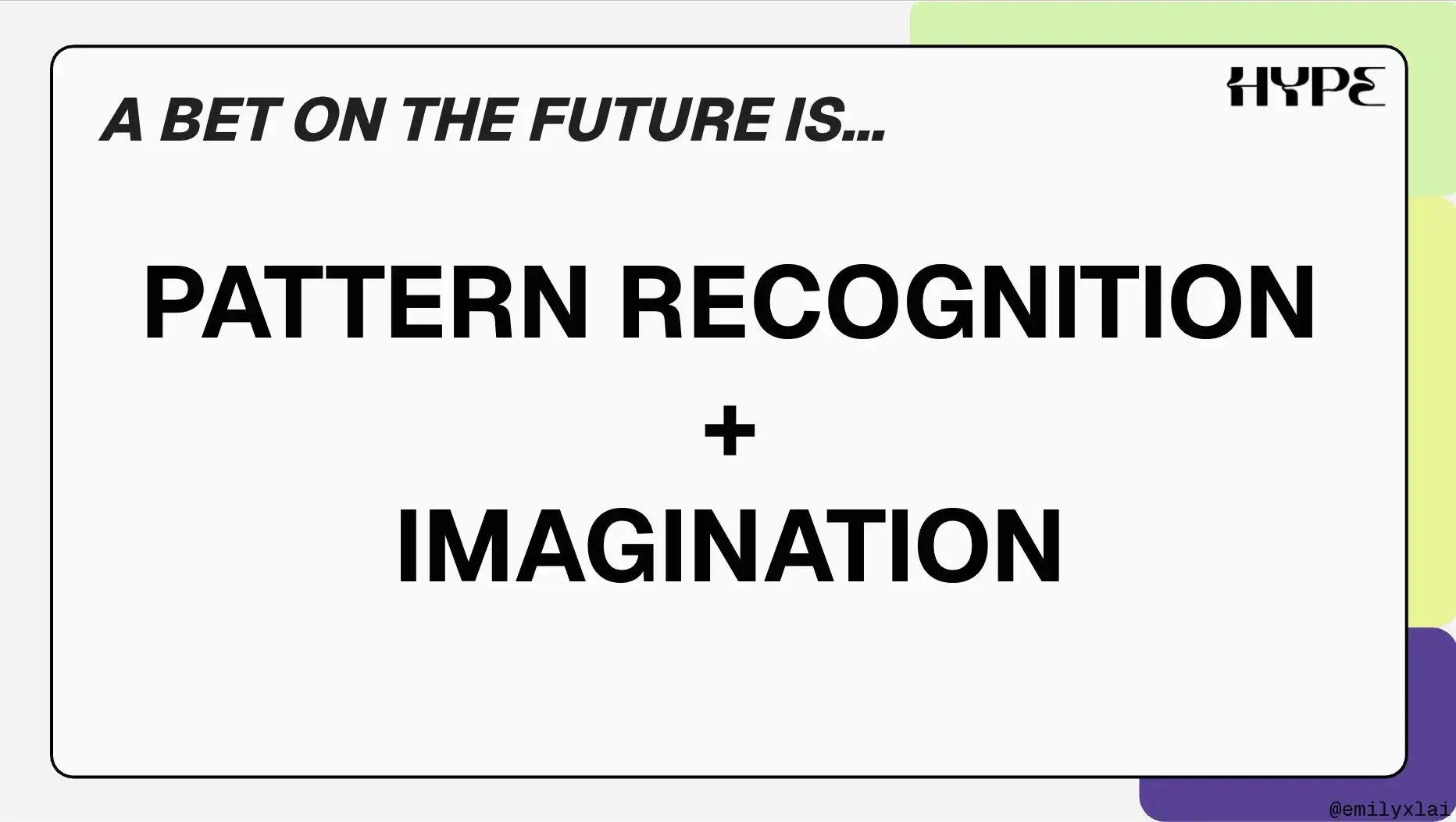
[Original link]
免责声明:本文章仅代表作者个人观点,不代表本平台的立场和观点。本文章仅供信息分享,不构成对任何人的任何投资建议。用户与作者之间的任何争议,与本平台无关。如网页中刊载的文章或图片涉及侵权,请提供相关的权利证明和身份证明发送邮件到support@aicoin.com,本平台相关工作人员将会进行核查。



